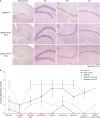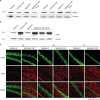2. Zlotnik I, Rennie JC. Further observations on the experimental transmission of scrapie from sheep and goats to laboratory mice. J Comp Pathol. 1963; 73:150–162.


3. Asuni AA, Gray B, Bailey J, Skipp P, Perry VH, O'Connor V. Analysis of the hippocampal proteome in ME7 prion disease reveals a predominant astrocytic signature and highlights the brain-restricted production of clusterin in chronic neurodegeneration. J Biol Chem. 2014; 289:4532–4545.


4. Rubenstein R, Bulgin MS, Chang B, Sorensen-Melson S, Petersen RB, LaFauci G. PrP(
Sc) detection and infectivity in semen from scrapie-infected sheep. J Gen Virol. 2012; 93:1375–1383.

5. Choi JK, Park SJ, Jun YC, Oh JM, Jeong BH, Lee HP, Park SN, Carp RI, Kim YS. Generation of monoclonal antibody recognized by the GXXXG motif (glycine zipper) of prion protein. Hybridoma (Larchmt). 2006; 25:271–277.


6. Fraser H. The pathology of natural and experimental scrapie. In : Kimberlin RH, editor. Slow Virus Diseases of Animals and Man. North-Holland, Amsterdam: 1976. p. 267–303.
7. Kim YS, Carp RI, Callahan S, Wisniewski HM. Incubation periods and histopathological changes in mice injected stereotaxically in different brain areas with the 87V scrapie strain. Acta Neuropathol. 1990; 80:388–392.


8. Ragagnin A, Ezpeleta J, Guillemain A, Boudet-Devaud F, Haeberlé AM, Demais V, Vidal C, Demuth S, Béringue V, Kellermann O, Schneider B, Grant NJ, Bailly Y. Cerebellar compartmentation of prion pathogenesis. Brain Pathol. 2018; 28:240–263.


9. Béringue V, Vilotte JL, Laude H. Prion agent diversity and species barrier. Vet Res. 2008; 39:47.


10. Bruce ME, McBride PA, Jeffrey M, Scott JR. PrP in pathology and pathogenesis in scrapie-infected mice. Mol Neurobiol. 1994; 8:105–112.


11. Dickinson AG. Scrapie in sheep and goats. In : Kimberlin RH, editor. Slow Virus Diseases of Animals and Man. North-Holland, Amsterdam: 1976. p. 209–239.
12. Kimberlin RH. Early events in the pathogenesis of scrapie in mice: biological and biochemical studies. In : Prusiner SB, Hadlow WJ, editors. Slow Transmissible Diseases of the Nervous System. New York: Academic Press;1979. p. 33–54.
13. Marsh RF, Bessen RA, Lehmann S, Hartsough GR. Epidemiological and experimental studies on a new incident of transmissible mink encephalopathy. J Gen Virol. 1991; 72:589–594.


14. Shi Q, Xiao K, Zhang BY, Zhang XM, Chen LN, Chen C, Gao C, Dong XP. Successive passaging of the scrapie strains, ME7-ha and 139A-ha, generated by the interspecies transmission of mouse-adapted strains into hamsters markedly shortens the incubation times, but maintains their molecular and pathological properties. Int J Mol Med. 2015; 35:1138–1146.


15. Taylor DM, Dickinson AG, Fraser H, Marsh RF. Evidence that transmissible mink encephalopathy agent is biologically inactive in mice. Neuropathol Appl Neurobiol. 1986; 12:207–215.


16. Beck KE, Thorne L, Lockey R, Vickery CM, Terry LA, Bujdoso R, Spiropoulos J. Strain typing of classical scrapie by transgenic mouse bioassay using protein misfolding cyclic amplification to replace primary passage. PLoS One. 2013; 8:e57851.

17. Cunningham C, Deacon RM, Chan K, Boche D, Rawlins JN, Perry VH. Neuropathologically distinct prion strains give rise to similar temporal profiles of behavioral deficits. Neurobiol Dis. 2005; 18:258–269.


18. Beck KE, Sallis RE, Lockey R, Vickery CM, Béringue V, Laude H, Holder TM, Thorne L, Terry LA, Tout AC, Jayasena D, Griffiths PC, Cawthraw S, Ellis R, Balkema-Buschmann A, Groschup MH, Simmons MM, Spiropoulos J. Use of murine bioassay to resolve ovine transmissible spongiform encephalopathy cases showing a bovine spongiform encephalopathy molecular profile. Brain Pathol. 2012; 22:265–279.



19. Brown DA, Bruce ME, Fraser JR. Comparison of the neuropathological characteristics of bovine spongiform encephalopathy (BSE) and variant Creutzfeldt-Jakob disease (vCJD) in mice. Neuropathol Appl Neurobiol. 2003; 29:262–272.


20. Bruce ME, McConnell I, Fraser H, Dickinson AG. The disease characteristics of different strains of scrapie in Sinc congenic mouse lines: implications for the nature of the agent and host control of pathogenesis. J Gen Virol. 1991; 72:595–603.


21. Sisó S, Chianini F, Eaton SL, Witz J, Hamilton S, Martin S, Finlayson J, Pang Y, Stewart P, Steele P, Dagleish MP, Goldmann W, Reid HW, Jeffrey M, González L. Disease phenotype in sheep after infection with cloned murine scrapie strains. Prion. 2012; 6:174–183.



22. Liu S, Sun J, Li Y. The neuroprotective effects of resveratrol preconditioning in transient global cerebral ischemia-reperfusion in mice. Turk Neurosurg. 2016; 26:550–555.


23. Sharma DR, Wani WY, Sunkaria A, Kandimalla RJ, Sharma RK, Verma D, Bal A, Gill KD. Quercetin attenuates neuronal death against aluminum-induced neurodegeneration in the rat hippocampus. Neuroscience. 2016; 324:163–176.


24. Cunningham C, Deacon R, Wells H, Boche D, Waters S, Diniz CP, Scott H, Rawlins JN, Perry VH. Synaptic changes characterize early behavioural signs in the ME7 model of murine prion disease. Eur J Neurosci. 2003; 17:2147–2155.


25. Hilton KJ, Cunningham C, Reynolds RA, Perry VH. Early hippocampal synaptic loss precedes neuronal loss and associates with early behavioural deficits in three distinct strains of prion disease. PLoS One. 2013; 8:e68062.

26. Jeffrey M, Halliday WG, Bell J, Johnston AR, MacLeod NK, Ingham C, Sayers AR, Brown DA, Fraser JR. Synapse loss associated with abnormal PrP precedes neuronal degeneration in the scrapie-infected murine hippocampus. Neuropathol Appl Neurobiol. 2000; 26:41–54.


27. Béringue V, Herzog L, Jaumain E, Reine F, Sibille P, Le Dur A, Vilotte JL, Laude H. Facilitated cross-species transmission of prions in extraneural tissue. Science. 2012; 335:472–475.


28. Jeffrey M, Begara-McGorum I, Clark S, Martin S, Clark J, Chaplin M, González L. Occurrence and distribution of infection-specific PrP in tissues of clinical scrapie cases and cull sheep from scrapie-affected farms in Shetland. J Comp Pathol. 2002; 127:264–273.











 PDF
PDF Citation
Citation Print
Print



 XML Download
XML Download